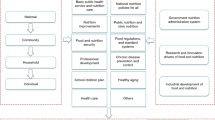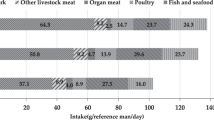Abstract
Latin America has experienced rapid demographic, epidemiological and nutrition changes that have successfully contributed to decreasing undernutrition, but concomitantly have resulted in an increase of obesity and associated conditions; in this paper we propose that policies to address undernutrition have not adapted at a sufficiently rapid pace to address the emerging challenges. Taking Chile as an example we show that health promotion policies, implemented only when the obesity epidemic was well advanced, have succeeded in establishing effective regulatory frameworks and in implementing national large-scale programs for treatment; however, they have been insufficient in preventing obesity. The main lessons learned are: (1) Failure to monitor existing malnutrition programs for changing needs and true effectiveness can have unintended consequences. (2) Institutions and professionals working in nutrition and health need to assess changing scenarios and redefine their priorities for action accordingly. (3) There is a need to provide updated information to decision makers, program planners and to the population at large on how to promote and achieve healthy food consumption and active living considering local context. Timely policies and interventions to address these issues may contribute to the prevention of the obesity epidemic in transitional countries, particularly among low socioeconomic groups.
This is a preview of subscription content, access via your institution
Access options
Subscribe to this journal
Receive 12 print issues and online access
$259.00 per year
only $21.58 per issue
Buy this article
- Purchase on Springer Link
- Instant access to full article PDF
Prices may be subject to local taxes which are calculated during checkout


Similar content being viewed by others
References
Popkin BM . The nutrition transition and obesity in the developing world. J Nutr 2001; 131: 871S–873S.
World Health Organization. Diet, nutrition and the prevention of chronic diseases. Report of a Joint WHO/FAO Expert Consultation. World Health Organization: Geneva, 2003.
National Institute of Statistics. Census 2002. National Institute of Statistics: Santiago, Chile, 2002.
National Institute of Statistics. Chile hacia el 2050. Proyecciones de población: Santiago, 2005.
Albala C, Vio F, Kain J, Uauy R . Nutrition transition in Chile: determinants and consequences. Public Health Nutr 2002; 5: 123–128.
Crovetto M . Changes in food structure and food consumption in Gran Santiago households 1988-1997. Rev Chil Nutr 2002; 29: 24–32.
Frenk J, Bobadilla J, Lozano R . The epidemiologic transition: the Latin American experience. In: Seminar on Causes and Prevention of Adult Mortality in Developing Countries. International Union for the Scientific Study of Population (IUSSP): Santiago, Chile, 1991.
Vio F, Albala C . Nutrition policy in the Chilean transition. Public Health Nutr 2000; 3: 49–55.
Kain J, Vio F, Albala C . Childhood nutrition in Chile: from deficit to excess. Nutr Res 1998; 18: 1825–1835.
Kain J, Uauy R . Targeting strategies used by the Chilean Supplementary Feeding Programme. Nutr Res 2001; 21: 677–688.
Kain J, Vial I, Muchnik E, Contreras A . An evaluation of the enhanced Chilean Supplementary Feeding Program. Arch Latinoamer Nutr 1994; 44: 242–250.
Kain J, Pizarro F . Effect of an enhanced supplementary feeding program on infant́s lenght. Arch Latinoamer Nutr 1997; 47: 101–104.
Uauy R, Riumalló J . Work Plan in Support of Guidelines on Formualting and Implementing Nutrition Programs (FINP) at the Country Level. Case Study. FAO: Chile, 1997.
Rojas J, Corvalán C . Avance de la junta nacional de jardines infantiles en la incorporación de los estándares de crecimiento OMS 2006. Rev chil nutr 2010; 37: 408–417.
Uauy R, Albala C, Kain J . Obesity trends in Latin America: transiting from under- to overweight. J Nutr 2001; 131: 893S–899S.
Rojas J, Uauy R . Need to prevent obesity without neglecting the protection of children at risk of malnutrition. Rev Chil Nutr 1999; 26: 35–39.
Rojas J, Uauy R . Evolucion de las normas de alimentacion y nutricion del programa alimentario y cambios en el estado nutricional de preescolares beneficiarios de la JUNJI en las ultimas 3 decadas. Rev Chil Nutr 2006; 33: 91–101.
Corvalan C, Uauy R, Flores R, Kleinbaum D, Martorell R . Reductions in the energy content of meals served in the Chilean National Nursery School Council Program did not consistently decrease obesity among beneficiaries. J Nutr 2008; 138: 2237–2243.
Food and Agriculture Organization of the United Nations. Targeting for Nutrition Improvement Resources for advancing nutritional well-being. Rome 2001.
Author information
Authors and Affiliations
Corresponding author
Ethics declarations
Competing interests
The authors declare no conflict of interest.
Rights and permissions
About this article
Cite this article
Garmendia, M., Corvalan, C. & Uauy, R. Addressing malnutrition while avoiding obesity: minding the balance. Eur J Clin Nutr 67, 513–517 (2013). https://doi.org/10.1038/ejcn.2012.190
Received:
Accepted:
Published:
Issue Date:
DOI: https://doi.org/10.1038/ejcn.2012.190
Keywords
This article is cited by
-
Healthcare professionals’ perceptions of childhood obesity in Iquitos, Peru: a qualitative study
BMC Health Services Research (2022)
-
Selection of complementary foods based on optimal nutritional values
Scientific Reports (2017)
-
Strong nutrition governance is a key to addressing nutrition transition in low and middle-income countries: review of countries’ nutrition policies
Nutrition Journal (2014)
-
A Latin American Perspective on the New ACC/AHA Clinical Guidelines for Managing Atherosclerotic Cardiovascular Disease
Current Atherosclerosis Reports (2014)



